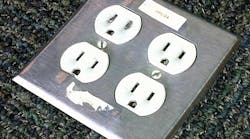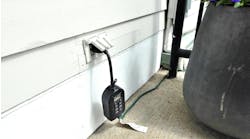How well do you know the Code? Think you can spot violations the original installer either ignored or couldn’t identify? Here’s your chance to moonlight as an electrical inspector and second-guess someone else’s work from the safety of your living room or office. Can you identify the specific Code violation(s) in this photo? Note: Submitted comments must include specific references from the 2014 NEC.
Hint: Wall-to-wall problems
Tell Them What They Have Won...
Using the 2014 NEC, correctly identify the Code violation(s) in this month’s photo — in 200 words or less — and you could win an Arlington Industries TVL508 Low Profile TV BOX. E-mail your response, including your name and mailing address, to [email protected], and Russ will select three winners (excluding manufacturers and prior winners) at random from the correct submissions. Note that submissions without an address will not be eligible to win.
July Winners
Section 300.3(A) prohibits single conductors from being installed unless they are part of a recognized Chapter 3 wiring method. Section 310.10 similarly states that conductors described in 310.104 are permitted to be used in Chapter 3 wiring methods. Section 300.20(B) requires slots to be cut between each hole where the individual conductors pass through. The internal clamps on the nonmetallic box are most likely not designed to be used with individual conductors. In fact, it appears as though the clamp has been completely pried out. This would be a violation of Sec. 110.3(B), since the instructions or listing do not permit this.






